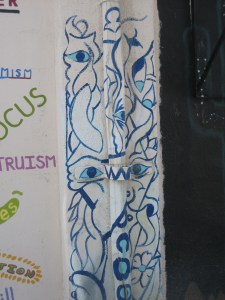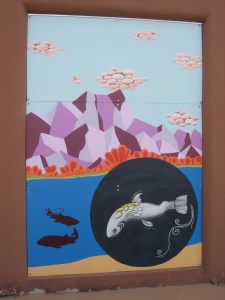
I’d been to and through San Luis, CO a few times, but I’d never before stopped the vehicle and walked around taking photos. This time was different. This time I stopped, even though I was tired and hungry. This time I walked up and down the main drag (Main Street/ Highway 159) and took some photos. Today I’ll share my mini adventure with you.
According to Wikipedia,
The Town of San Luis is a statutory town that is the county seat and the most populous town of Costilla County, Colorado, United States…[7]The population was 629 at the 2010 census.[8]
The big claim to fame of San Luis is that it’s the oldest town in Colorado. This fact is proclaimed right on the town’s welcome signs.

The San Luis town website has a section about the town’s history. The website explains,
San Luis, the oldest town in Colorado, was established on April 5, 1851…Hispanic settlers from the Taos Valley established several small villages along the Rio Culebra in the San Luis Valley and officially took possession of this portion of the Sangre de Cristo Land Grant on April 5, 1851. Settlers built a church in the central village of La Plaza Medio and dedicated it on the Feast of Saint Louis, June 21, 1851.The village was renamed San Luis de la Culebra in honor of its patron saint. San Luis remained part of the Territory of New Mexico until 1861 when the Territory of Colorado was established. Today, San Luis is the oldest continuously inhabited town in the state of Colorado.
San Luis is home to the Shrine of the Stations of the Cross. The Catholic Travel Guide website says the Shrine
is located on a mesa in the center of San Luis. Dedicated in 1990, the Shrine was built as an act of faith and love for the parishioners of the Sangre de Cristo Parish. It is a place of prayer and solace open to members of all faiths and people of good will.

I did not visit the Shrine on the day I stopped in San Luis to take photos. I do hope to visit the Shrine someday. I’m sure such a visit would lead to bloggable moments, and I’d certainly share my experience there with you.
For such a small town, San Luis has a lot of murals. Many of the buildings on the main street have murals painted on their sides. I parked next to a mural called Mexica Tiahui. (I found out when researching this post that the building I parked next to houses San Luis’ town hall/court/police station/visitor center.)

‘Mexica Tiahui’ mural in San Luis, CO 
Detail of ‘Mexica Tiahui ‘mural in San Luis, CO
According to the Waymarking.com listing for this piece of art, the mural was completed in 2018 and was
[d]esigned and painted by local students…and explores the students reclaiming their indigenous heritage.
The aforementioned website goes on to say,
Mexica Tiahui! I’ve always known the spirited sentiment to mean “Mexican (Indigenous) Moving/Go Forward!” It is used as a positive exclamation mostly by Chicanah (Chican@) people in the United States who are using “Mexica” as an identity point in reclaiming their Indigenous self. [There’s quite about more information about the term “Mexica Tiahui!” is the long description on the Waymarking.com page.]
This large mural features the students of San Luis (who were the designers and artists), Spanish explorers/conquerors, the Catholic Church, and Aztec monuments and peoples.
Waymarking.com also lists the mural Sierras y Colores (“mountain range and colors”) by Carlos Sandoval. The website says,
This mural on the side of the Full Circle building explores the history and cultures of the San Luis valley. A woman is carrying a basket of vegetables grown in the area, early settlers are remembered, The Spanish Conquistadors and Christianity (in the form of Christ and Catholicism), Ute Indian on a pony, the San Luis People’s Ditch (early community irrigation), a ranch hand branding a cow, and a resident with a dead deer on the back of the saddle.

Sierras y Colores mural by Carlos Sandoval. Click on this photo to see the entire piece. 
Detail from the mural Sierras y Colores
Another mural I encountered was on the deserted Custom Cycles shop. Unfortunately, I couldn’t find any information about the artist.

Mural on the old Custom Cycles building on Main Street in San Luis. Click on this photo to see the entire mural. 
Detail of the Custom Cycles mural
There were other murals in San Luis I couldn’t find any information about online.

I love that elements of this mural are 3-dimensional. 
Casa de Amistad 
This mural faces Main Street 
This mural facing Main Street has seen better days. That peeling paint makes me sad.
I also liked looking at the old buildings lining Main Street in San Luis, like the one housing the R&R Market.

I took lthis photo of the R&R market through my windshield during a previous trip. 
The R&R Market opened in 1857.
According to the Colorado Preservation, Inc. webpage about the R&R Market, it
is the oldest continuously operated business in the State of Colorado, dating from its establishment in 1857 in the town of San Luis by Costilla County pioneer Dario Gallegos. The building was partially rebuilt after fires in 1895 and 1947…
The building housing R&R Market was originally constructed of adobe bricks and has subsequently been modified with a combination of concrete block, plaster and stucco construction. The ground floor is the market and the upstairs includes rental units which were once part of a hotel. The original mercantile business was opened…in May, 1857, in a building 20 feet wide by 40 feet long, made of 25-inch adobe walls, with a foundation of rock with mud mortar. Today the building is a beautiful two-story log and stucco building in the Territorial Adobe style…
On the day in March 2020 I visited San Luis, I really wanted to stop in at the R&R Market to look for postcards, but the threat of COVID-19 kept me out. I hope one day I can go into the market and find postcards celebrating San Luis’ oldest town status.
My favorite part of this building is those script letters! I could find nothing online about this building or the company it housed.

In addition to the town’s murals and old buildings, I enjoyed looking at the old signs in San Luis.

Liquor proud 
Ice, ice, baby…beer, pop, wine. 
Love, love, love that barber pole. 
Sure, I would eat here, if I weren’t physical distancing.
Finally, I liked the old payphones still standing in San Luis.

Payphone in front of the gas station in the middle of town. 
I actually took this photo of not-a-payphone in summer 2019.
There’s a cultural center I didn’t visit because of the threat of COVID-19. Maybe next time, when I go to see the Shrine. I’ll try to pick up some postcards then too. Hopefully I can go back before too long.

I took the photos in this post.


















































































































